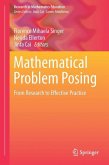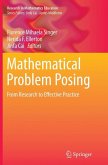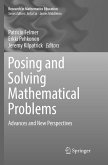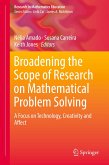Research in Mathematical Problem Posing
New Advances and Directions
Herausgegeben:Cai, Jinfa; Leikin, Roza
Research in Mathematical Problem Posing
New Advances and Directions
Herausgegeben:Cai, Jinfa; Leikin, Roza
- Gebundenes Buch
- Merkliste
- Auf die Merkliste
- Bewerten Bewerten
- Teilen
- Produkt teilen
- Produkterinnerung
- Produkterinnerung
This book explores mathematical problem posing in education, a topic of interest for at least 40 years. Over time, a research community has gradually formed around studying mathematical problem posing as a phenomenon of its own and as a component of mathematics instruction. This book is to provide advances on the impact of scholars (e.g., Polya, Kilpatrick, Brown, Walter, and Silver) and the role of problems in the development of mathematical ideas. It is the first book, which systematically explores the problem-posing processes, both cognitively and affectively. The book reports studies that…mehr
Andere Kunden interessierten sich auch für
![Innovations in Initial Mathematics Teacher Education Innovations in Initial Mathematics Teacher Education]() Innovations in Initial Mathematics Teacher Education129,99 €
Innovations in Initial Mathematics Teacher Education129,99 €![Mathematical Problem Posing Mathematical Problem Posing]() Mathematical Problem Posing130,99 €
Mathematical Problem Posing130,99 €![Mathematical Problem Posing Mathematical Problem Posing]() Mathematical Problem Posing129,99 €
Mathematical Problem Posing129,99 €![Posing and Solving Mathematical Problems Posing and Solving Mathematical Problems]() Posing and Solving Mathematical Problems136,99 €
Posing and Solving Mathematical Problems136,99 €![Broadening the Scope of Research on Mathematical Problem Solving Broadening the Scope of Research on Mathematical Problem Solving]() Broadening the Scope of Research on Mathematical Problem Solving85,99 €
Broadening the Scope of Research on Mathematical Problem Solving85,99 €![Problem-posing with Multicultural Children's Literature Problem-posing with Multicultural Children's Literature]() Elizabeth P. QuinteroProblem-posing with Multicultural Children's Literature40,50 €
Elizabeth P. QuinteroProblem-posing with Multicultural Children's Literature40,50 €![Toward Equity and Social Justice in Mathematics Education Toward Equity and Social Justice in Mathematics Education]() Toward Equity and Social Justice in Mathematics Education129,99 €
Toward Equity and Social Justice in Mathematics Education129,99 €-
-
-
This book explores mathematical problem posing in education, a topic of interest for at least 40 years. Over time, a research community has gradually formed around studying mathematical problem posing as a phenomenon of its own and as a component of mathematics instruction. This book is to provide advances on the impact of scholars (e.g., Polya, Kilpatrick, Brown, Walter, and Silver) and the role of problems in the development of mathematical ideas. It is the first book, which systematically explores the problem-posing processes, both cognitively and affectively. The book reports studies that employ problem posing as an instructional approach directed at deepening students understanding of learning mathematics, knowledge, skills, and cognitive and affective characteristics related to their learning of mathematics. In addition, this book examines issues related to teachers and their learning when they start to take on mathematical problem posing as an instructional practice. It describes not only changes in teachers beliefs and classroom instruction as a result of engaging in problem posing, but also teachers instructional expertise of teaching mathematics through problem posing.
Produktdetails
- Produktdetails
- Research in Mathematics Education
- Verlag: Springer / Springer Nature Switzerland / Springer, Berlin
- Artikelnr. des Verlages: 89292060, 978-3-032-05492-0
- Seitenzahl: 618
- Erscheinungstermin: 12. März 2026
- Englisch
- Abmessung: 235mm x 155mm
- ISBN-13: 9783032054920
- ISBN-10: 3032054923
- Artikelnr.: 75134447
- Herstellerkennzeichnung
- Springer-Verlag GmbH
- Tiergartenstr. 17
- 69121 Heidelberg
- ProductSafety@springernature.com
- Research in Mathematics Education
- Verlag: Springer / Springer Nature Switzerland / Springer, Berlin
- Artikelnr. des Verlages: 89292060, 978-3-032-05492-0
- Seitenzahl: 618
- Erscheinungstermin: 12. März 2026
- Englisch
- Abmessung: 235mm x 155mm
- ISBN-13: 9783032054920
- ISBN-10: 3032054923
- Artikelnr.: 75134447
- Herstellerkennzeichnung
- Springer-Verlag GmbH
- Tiergartenstr. 17
- 69121 Heidelberg
- ProductSafety@springernature.com
Jinfa Cai is the Kathleen and David Hollowell Professor at the University of Delaware, an elected member of USA National Academy of Education (NAEd) and a Fellow of American Educational Research Association (AERA). Jinfa received his B.S. in mathematics from Hangzhou Normal University, M.Ed. in mathematics education from Beijing Normal University, and his Ph.D. in Cognitive Studies (in mathematics education) from the University of Pittsburgh. He served as the Editor-in-Chief for the Journal for Research in Mathematics Education (2017-2020). He also served as Program Director at the USA National Science Foundation. He is the Editor of the 2017 Compendium for Research in Mathematics Education, by NCTM. Currently, he is the vice-president of International Commission of Mathematical Instruction (ICMI). His research is well-funded from various funding agencies, such as the USA National Science Foundation, Department of Education, and Spencer Foundation. Currently, he is working on a 4-year longitudinal research project on problem posing. Dr. Roza Leikin is a Professor of Mathematics Education and Gifted Education at the Faculty of Education, University of Haifa and since October 2020, she serves as the Faculty Dean. Dr. Leikin is the Establishing Director of the RANGE Center - the Interdisciplinary Center for the Research and Advancement of Giftedness and Excellence. Prof. Leikin's research focuses mathematical creativity and ability, task design, teachers' professional potential, and integration of neuro-cognitive research to the field of mathematics education. From 2012-2017 she served as the President of the International Group for Mathematical Creativity and Giftedness and was the Head of the National Advisory Board in Mathematics Education of the Israeli Ministry of Education. Since 2013 she is serving as a Senior Mathematics Education Editor of the International Journal of Science and Mathematics Education. She has edited 13 volumes related to research in mathematics and gifted education and has published more than 180 papers and chapters in peer reviewed research.
Chapter 1. New Advances and Directions of Mathematical Problem-Posing Research.- Part 1: History and Fundamentals of Problem-Posing Research.- Chapter 2. Teaching Mathematics Through Problem Posing: Contributions of Brown and Walter s Book The Art of Problem Posing in Problem-Posing Research.- Chapter 3. Problem Formulating as a Gateway to Problem Posing: A Retrospective Look.- Chapter 4. Footprints Through a Landscape of Mathematical Problems: Edward Silver and His Research on Mathematical Problem Posing.- Chapter 5. How Mathematicians Pose Problems: A Historical Examination.- Chapter 6. Solving a Problem as a Catalyst for Problem Posing.- Chapter 7. Research On Mathematical Creativity and Problem Posing: State of the Art and Future Development.- Chapter 8. Reviewing the Current State of Knowledge in Mathematical Problem-Posing Research.- Part 2: Process of Problem Posing.- Chapter 9. Unstructured Situations as Initiation for Problem-Posing Processes: Validation of a Descriptive Phase Model of Problem Posing.- Chapter 10. Investigating the Use of Prompts on Prospective Mathematics Teachers Problem-Posing Processes.- Chapter 11. Mathematical Problem-Posing Abilities: A Study of Chilean Upper Primary Students.- Chapter 12. Influence of the Characteristics of Problem-Posing Situations on Preservice Teachers Performance and Affective Processes.- Chapter 13. Exploring Connections Between Problem Posing and Problem Solving: Illustrations of Problem Posing as Meaning-Making Within Problem Solving.- Chapter 14. Motivating Discussion of Problem Posing Through Forums in Asynchronous Elementary Mathematics Education Courses.- Chapter 15. How Problems Are Posed: Some Observations.- Chapter 16. Reformulation and Generation as Facets of Problem Posing and Their Relationships with Mathematical Performance and Creativity.- Chapter 17. Fostering Meaningful Problem Posing Through Playful Math.- Part 3: Teaching and Learning Mathematics through Problem Posing.- Chapter 18. Operationalization of the Educational Objectives via Problem Posing in Education of Prospective Primary Teachers.- Chapter 19. Charting the Domain of Challenges Associated with the Design and Implementation of Interventions for Enhancing Mathematical Problem-Posing Competence.- Chapter 20. Facilitating Authentic Problem Posing in Mathematical Modelling: A Case of 12th-Grade Students.- Chapter 21. Utilizing Problem Posing to Teach Whole Number Word Problem Structures.- Chapter 22. From Professional Development to the Classroom: The Spiral Model of Teachers Problem Posing for their Students.- Chapter 23. Teaching Mathematics Through Problem Posing in Early Childhood: Exploring the Relationship Between a Task and the Problems Posed by Students.- Part 4: Teacher and Teacher Learning with Respect to Problem Posing.- Chapter 24. Challenging Teachers to Solve and Pose Challenging Problems A Case Study.- Chapter 25. Problem Posing, Trait Curiosity, and Mathematical Curiosity.- Chapter 26. Problem Posing as a Means for Developing Preservice Teachers Mathematical Creativity.- Chapter 27. Problem Posing in Preservice Math Teacher Education in Brazil.- Chapter 28. The Power of a Five-Finger Problem-Posing Strategy in the Mathematics Classroom.
Chapter 1. New Advances and Directions of Mathematical Problem-Posing Research.- Part 1: History and Fundamentals of Problem-Posing Research.- Chapter 2. Teaching Mathematics Through Problem Posing: Contributions of Brown and Walter s Book The Art of Problem Posing in Problem-Posing Research.- Chapter 3. Problem Formulating as a Gateway to Problem Posing: A Retrospective Look.- Chapter 4. Footprints Through a Landscape of Mathematical Problems: Edward Silver and His Research on Mathematical Problem Posing.- Chapter 5. How Mathematicians Pose Problems: A Historical Examination.- Chapter 6. Solving a Problem as a Catalyst for Problem Posing.- Chapter 7. Research On Mathematical Creativity and Problem Posing: State of the Art and Future Development.- Chapter 8. Reviewing the Current State of Knowledge in Mathematical Problem-Posing Research.- Part 2: Process of Problem Posing.- Chapter 9. Unstructured Situations as Initiation for Problem-Posing Processes: Validation of a Descriptive Phase Model of Problem Posing.- Chapter 10. Investigating the Use of Prompts on Prospective Mathematics Teachers Problem-Posing Processes.- Chapter 11. Mathematical Problem-Posing Abilities: A Study of Chilean Upper Primary Students.- Chapter 12. Influence of the Characteristics of Problem-Posing Situations on Preservice Teachers Performance and Affective Processes.- Chapter 13. Exploring Connections Between Problem Posing and Problem Solving: Illustrations of Problem Posing as Meaning-Making Within Problem Solving.- Chapter 14. Motivating Discussion of Problem Posing Through Forums in Asynchronous Elementary Mathematics Education Courses.- Chapter 15. How Problems Are Posed: Some Observations.- Chapter 16. Reformulation and Generation as Facets of Problem Posing and Their Relationships with Mathematical Performance and Creativity.- Chapter 17. Fostering Meaningful Problem Posing Through Playful Math.- Part 3: Teaching and Learning Mathematics through Problem Posing.- Chapter 18. Operationalization of the Educational Objectives via Problem Posing in Education of Prospective Primary Teachers.- Chapter 19. Charting the Domain of Challenges Associated with the Design and Implementation of Interventions for Enhancing Mathematical Problem-Posing Competence.- Chapter 20. Facilitating Authentic Problem Posing in Mathematical Modelling: A Case of 12th-Grade Students.- Chapter 21. Utilizing Problem Posing to Teach Whole Number Word Problem Structures.- Chapter 22. From Professional Development to the Classroom: The Spiral Model of Teachers Problem Posing for their Students.- Chapter 23. Teaching Mathematics Through Problem Posing in Early Childhood: Exploring the Relationship Between a Task and the Problems Posed by Students.- Part 4: Teacher and Teacher Learning with Respect to Problem Posing.- Chapter 24. Challenging Teachers to Solve and Pose Challenging Problems A Case Study.- Chapter 25. Problem Posing, Trait Curiosity, and Mathematical Curiosity.- Chapter 26. Problem Posing as a Means for Developing Preservice Teachers Mathematical Creativity.- Chapter 27. Problem Posing in Preservice Math Teacher Education in Brazil.- Chapter 28. The Power of a Five-Finger Problem-Posing Strategy in the Mathematics Classroom.








